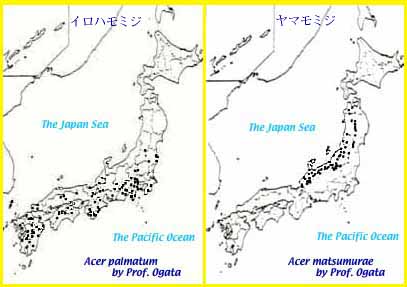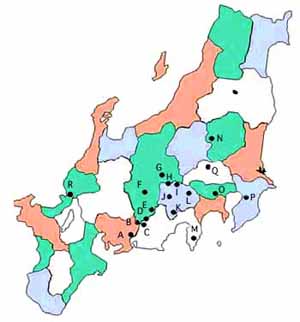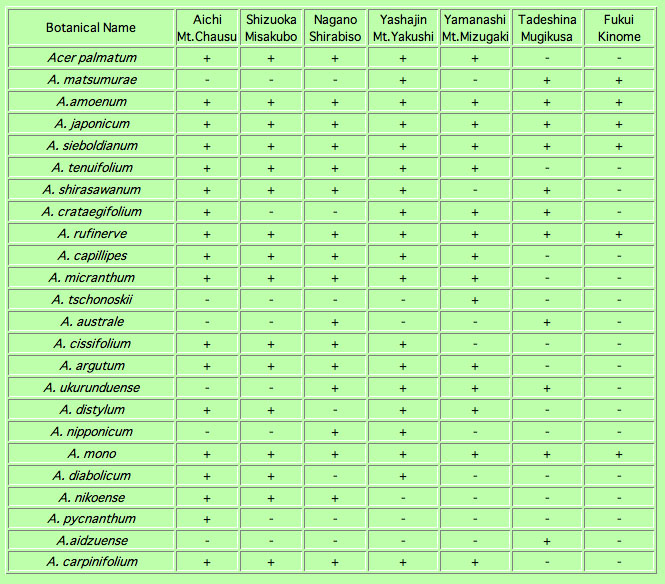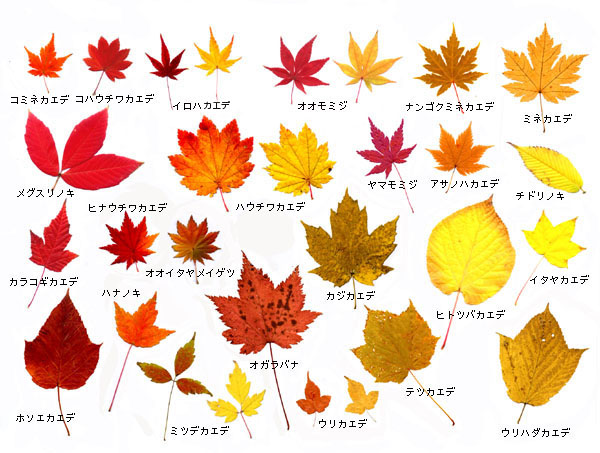5. Japanese Maples .......................................................... Japanese
Horizontal distribution and vertical distribution
It is generally said that horizontal distribution is the distribution of the vegetation corresponding to climatic zones, such as arctic zone, temperate zone and tropical zone, which are owing to the climatic conditions, such as temperature and precipitation, and the vegetation contains the needle-leaved trees, deciduous broad-leaved trees, ever-green broad-leaved trees, etc. The difference of such conditions are also contained as high humidity when hot in Japan, and as high humidity when cold in Europe.
And is said that vertical distribution is the distribution of vegetation according to the height above sea level. The conditions of vertical distribution change owing to latitudinal difference. This generally means that what are at high places in the south are at lower places in the north, but the conditions of distribution are influenced by the accumulated temperatures and the underground moisture content except the average values of temperature and humidity."In the region of the Himalayas, the upper limit of a rice crop is about 1800m, and that of bananas is about 2000m in Nepal and its neighborhood. Even in cold places where a rice crop cannot be grown, bananas can be cultivated. On the south side of the Himalayas it's warm in winter and fairly cool in summer similar to the character of an alpine climate in the tropics. As rice is the summer crop, the upper limit of rice is determined by the accumulated temperature in summer, on the other hand, that of bananas is determined by the coldness in winter. It is a strange phenomenon that bananas can be cultivated up in higher places."
(quoted from "Shohyohjurin Bunka" by Nakao Sasuke, Ueyama Shumpei; my translation)Physiographic factors and climatic factors also have influence on maple distribution.
Let me show a few here.Maples having the characteristic distribution
1. Iroha-momiji (Acer palmatum) & Yama-momiji (Acer matsumurae)
Iroha-momiji, yama-momiji and o-momiji (Acer amoenum) can be regarded as the same family. Iroha-momiji are distributed along the Pacific coast (except Hokkaido & the northern Honshu), and yama-momiji along the Japan Sea coast (from Aomori to Fukui Prefecture). (based on the document No.3 by Prof.Ogata )

It seems possible for us to discriminate roughly among 3 species with the addition of o-momiji. But now as there are many kinds of cultivars in addition to these 3 natural species, it might be fairly difficult for us to distinguish accurately by the shape of a leaf when asked what kind it belongs to. They all are generally called "momiji."
2. Hananoki (Acer pycnanthum)
This maple is loved as the Tree of Aichi Prefecture. The distribution of the natural Hananoki is limited to Aichi,Gifu and Nagano Prefecture, and the Kiso basin. Some has been designated as natural monuments. I've been to Anan (Nagano), Sakamoto (Gifu) and Yukiyoshi Shrine (Aichi). Their pictures are on this homepage at the item "Autumn color mechanism" and in the "list of Japanese maples." The Hananokis at Kita-hanazawa and Minami-hanazawa (Shiga) are said to be transplanted, and there seems to be a tradition that Shotoku-Taishi himself planted them. (from document No.1)
3. Kusunoha-kaede (Acer oblongum)
This species is from Ryukyu (Okinawa Prefecture), as well as Taiwan and Himalayas. The shape of the leaves is like that of camphor's leaves, which are non-lobed. This is the only maple whose leaves are ever-green in Japan (from document No.15).
4. Kurobi-itaya (Acer miyabei)
I hear this is similar to Itaya-kaede (Acer mono), is in the same group as Hedge maple (Acer campestre), and is rarely seen in Hokkaido and Tohoku District. I've seen this maple at the Nikko Botanical Garden, and I would like to see this species at the place where they originate.
Vertical distribution of Chubu District (mainly concerning Shizuoka Prefecture)
... Subalpine zone above 1600m : Mine-kaede and Ogarabana
Mine-kaede (Acer tschonoskii) could be seen at the Mugikusa Pass (2127m), the Shirabiso Highlands (1833m), Mt. Mizugaki, etc., Ogarabana (Acer ukurunduense) at halfway up Mt. Yakushidake, the Yachiho Highlands, halfway up Mt.Mizugaki and in the Shirabiso Highlands.
... Above 1300m :
Tetsu-kaede (Acer nipponicum) at halfway up Mt.Yakushidake and on the way from the Yashajin Pass to Hirogawara
... Below 1000m :
Hananoki (Acer pycnanthum), Iroha-momiji (Acer palmatum), Toh-kaede (Acer buergerianum), Uri-kaede (Acer crataegifolium), Yama-momiji (Acer matsumurae, in Fukui Prefecture)
... From 1000m to 1300m :
Many species in addition to those mentioned above are distributed from1000m to 1300m. In Shizuoka Prefecture we can arrive at these places by a 2 hour drive from the Pacific Coast, such as Mt. Chausu, the Hyogoshi Pass, the Aokuzure Pass, Ikawa, Sumata Ravine, Umegashima, Mt. Minobu, Mt. Fuji and the Izu Amagi Pass. We can see the following species at these places.
O-momiji (Acer amoenum), Hauchiwa-kaede (Acer japonicum), Ko-hauchiwa-kaede (Acer sieboldianum), Hina-uchiwa-kaede (Acer tenuifolium), O-itaya-meigetsu (Acer shirasawanum), Urihada-kaede (Acer rufinerve), Hosoe-kaede (Acer capillipes), Itaya-kaede (Acer mono), Hitotsuba-kaede (Acer distylum), Chidorinoki (Acer carpinifolium), Mitsude-kaede (Acer cissifolium), Megusurinoki (Acer nikoense),
Karakogi-kaede (Acer ginnala ), Asanoha-kaede (Acer argutum), Komine-kaede (Acer micranthum), Kaji-kaede (Acer diabolicum)The natural maple which I saw for the first time was an Uri-kaede. My maple observation commonly started from the low place. Then followed Hananoki, Itaya-kaede, and the last ones were Tetsu-kaede, Ogarabana and Mine-kaede. To tell the truth, maple distribution maps by Prof. Ogata were my best guide for these personal observations. In the mountains there were many happenings, such as getting seperated from my wife, the wheel lifting from uneven spots, slipping down the slope, meeting deer and meeting monkeys with surprise.

A : Aichi Kenmin forest, B : Mt. Chausu, C : Misakubo, D : the Aokuzure Pass, the Hyogoshi Pass, Mt.Azabu, E : the Shirabiso Pass, F : Mt. Kiso-Komagatake, G : Tadeshina, the Mugikusa Pass, Yachiho Highland, H : Mt.Yatsugatake, I : Masutomi, Mt.Mizugaki, J : Mt.Yakushidake, the Yashajin Pass, Hirogawara, K : Mt. Minobu, L : Nishizawa Ravine, M : the Amagi Pass, N : Nikko Botanical Garden (Tokyo Univ.), O : Jindai Botanical Garden, P : Chiba Botanical Experiment Station (Tokyo Univ.), Q : National Musashi Hillside Park, R : Kinome Pass, Tochinoki pass

Each mark"+" means what was recognized its existence by me.
Please regard these data as non official record by an amateur.
Acer buergerianum is not included, for it comes from China
and is frequently seen as a rodeside tree.
As mentioned above, we can observe 24 species in this Chubu district.
Let me show you autumn colors of the leaves on 24 species of maples in Chubu district.

As species of the natural maples in Japan, including the following species, such as kurobiitaya (Acer miyabei), kusunohakaede (A. oblongum), yakushimaonagakaede (A. morifolium) and shimaurikaede (A. insulare) , 28 species can be counted.
The count of species differs according to the scholar, I will regard the number of species as 29 here including tohkaede (Acer buergeianum from China). As regards the detailed examination of species, I'll add my explanation in the item called "Related items"